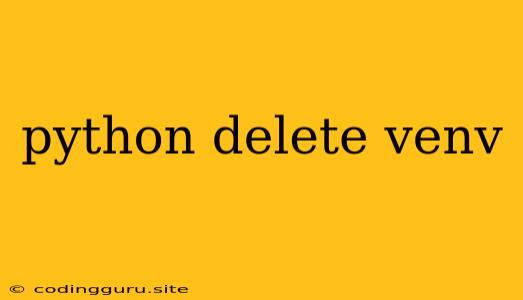How to Delete a Virtual Environment in Python
Virtual environments are a crucial part of managing Python projects. They isolate project dependencies, ensuring that different projects don't clash with each other. But what happens when you need to get rid of an old or unused virtual environment? This guide will walk you through the process of deleting a Python virtual environment.
Understanding Python Virtual Environments
Before we dive into deletion, let's quickly recap what virtual environments are. In essence, they are isolated containers for Python projects. When you create a virtual environment, it copies Python interpreter and packages into a specific directory, creating a self-contained environment for your project. This means:
- No Conflicts: Your project's dependencies don't interfere with other Python projects on your system.
- Project Isolation: You can install and manage specific versions of packages without affecting other projects.
Deleting a Python Virtual Environment
Now, let's tackle the task of deleting a virtual environment. The process is straightforward and involves removing the entire directory containing your virtual environment.
Step 1: Locate the Virtual Environment Directory
First, you need to find the location of the virtual environment you want to delete. By default, virtual environments are usually created in the project directory, but you can customize this during creation. Look for a folder named venv or .venv inside your project directory.
Step 2: Deactivate the Environment
If you're currently working within the virtual environment, you'll need to deactivate it before deleting. Deactivation is simply reversing the activation process.
-
On Linux/macOS: Type
deactivatein your terminal. -
On Windows: Type
deactivatein your command prompt.
Step 3: Remove the Virtual Environment Directory
Once you've deactivated the environment, you can delete the entire directory containing the virtual environment files. You can do this using your operating system's file explorer or using the command line:
-
On Linux/macOS: Use the
rmcommand. For example, to remove the virtual environment folder called 'venv', you would run:rm -rf venv -
On Windows: Use the
rmdircommand. For example, to remove the virtual environment folder called 'venv', you would run:rmdir /s /q venv
Important Note: The -rf flag in the rm command and the /s /q flags in the rmdir command are important. They ensure that the entire virtual environment directory and its contents are deleted recursively. Be extremely careful when using these flags, as they can lead to permanent data loss if used incorrectly.
Example:
Let's say you have a project called "my_project" and you want to delete its virtual environment. Assuming you used the default location:
- Locate the directory:
my_project/venv - Deactivate the environment:
deactivate(if it's activated) - Delete the directory:
- Linux/macOS:
rm -rf my_project/venv - Windows:
rmdir /s /q my_project/venv
- Linux/macOS:
Deleting a Specific Environment with Virtualenv
If you have multiple virtual environments and you'd like to delete a specific one without knowing its exact location, you can use the virtualenv package to find and delete it. Here's how:
- Install
virtualenv: If you haven't already, usepip install virtualenv. - List available environments: Run
virtualenv --listin your terminal to see the list of all available environments. - Delete the environment: Once you know the name or path of the environment you want to delete, use the
virtualenv --deletecommand. For example:virtualenv --delete my_env.
Tips for Managing Virtual Environments
- Organize Your Projects: Create separate directories for different Python projects to avoid confusion.
- Use Descriptive Names: When creating a virtual environment, give it a descriptive name that reflects the project it's associated with.
- Keep Track of Environments: Make a list of your active environments to avoid accidentally deleting the wrong one.
Conclusion
Deleting a Python virtual environment is a simple but essential task for maintaining a clean and organized development environment. Remember to always deactivate the environment before deleting and exercise caution with commands that remove files recursively. By following these steps and utilizing best practices, you can efficiently manage your virtual environments and keep your Python projects organized.
